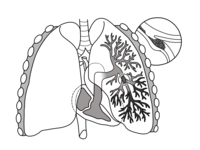
Antegrade slow pathway mapping of typical atrioventricular nodal reentrant tachycardia based on direct slow pathway capture
Sign Up to like & getrecommendations! Published in 2021 at "Journal of Arrhythmia"
DOI: 10.1002/joa3.12484
Abstract: Radiofrequency (RF) ablation of typical atrioventricular nodal reentrant tachycardia (tAVNRT) is performed without revealing out the location of antegrade slow pathway (ASp). In this study, we studied a new electrophysiological method of identifying the site… read more here.
Keywords: typical atrioventricular; atrioventricular nodal; pathway; slow pathway ... See more keywords

Randomized trial of intracardiac echocardiography-guided slow pathway ablation
Sign Up to like & getrecommendations! Published in 2022 at "Journal of Interventional Cardiac Electrophysiology"
DOI: 10.1007/s10840-022-01126-y
Abstract: Radiofrequency (RF) catheter ablation of the slow pathway (SP) in atrioventricular nodal reentry tachycardia (AVNRT) is highly effective; however, it may require prolonged fluoroscopy and RF time. We postulated that visualization of the SP region… read more here.
Keywords: slow pathway; ablation time; intracardiac echocardiography; ice ... See more keywords

Delayed occurrence of atypical fast-slow atrioventricular nodal reentry years after successful slow pathway ablation for typical atrioventricular nodal reentry
Sign Up to like & getrecommendations! Published in 2020 at "HeartRhythm Case Reports"
DOI: 10.1016/j.hrcr.2020.10.001
Abstract: When a patient who has undergone successful slow pathway ablation for typical AVNRT with elimination of symptoms develops a recurrent long Introduction Atrioventricular nodal reentrant tachycardia (AVNRT) is the most commonly diagnosed supraventricular tachycardia (SVT)… read more here.
Keywords: avnrt; ablation; nodal reentry; atrioventricular nodal ... See more keywords

Unmasking of a concealed slow pathway by atrioventricular simultaneous basic pacing.
Sign Up to like & getrecommendations! Published in 2018 at "Journal of electrocardiology"
DOI: 10.1016/j.jelectrocard.2017.09.012
Abstract: A 71-year-old woman with narrow QRS tachycardia was referred for catheter ablation. The clinical tachycardia was diagnosed as slow/fast form of atrioventricular (AV) nodal reentrant tachycardia (AVNRT) with the upper common pathway. Although neither conventional… read more here.
Keywords: unmasking concealed; pathway; atrioventricular simultaneous; pathway atrioventricular ... See more keywords

Voltage and propagation mapping: new tools to improve successful ablation of atrioventricular nodal reentry tachycardia
Sign Up to like & getrecommendations! Published in 2023 at "Europace"
DOI: 10.1093/europace/euad122.236
Abstract: Abstract Funding Acknowledgements Type of funding sources: None. Background Ablation of atrioventricular nodal reentry tachycardia (AVNRT) has become the treatment of choice for AVNRT due to high success and low complication rate. A 3-D reconstruction… read more here.
Keywords: ablation; collision; voltage; slow pathway ... See more keywords

Slow‐pathway visualization by using voltage‐time relationship: A novel technique for identification and fluoroless ablation of atrioventricular nodal reentrant tachycardia
Sign Up to like & getrecommendations! Published in 2020 at "Journal of Cardiovascular Electrophysiology"
DOI: 10.1111/jce.14481
Abstract: Atrioventricular nodal reentrant tachycardia (AVNRT) is treatable by catheter ablation. Advances in mapping‐system technology permit fluoroless workflow during ablations. As national practice trends toward fluoroless approaches, easily obtained, reproducible methods of slow‐pathway identification, and ablation… read more here.
Keywords: ablation; atrioventricular nodal; identification; slow pathway ... See more keywords

A prospective evaluation of the impact of individual RF applications for slow pathway ablation for AVNRT: Markers of acute success
Sign Up to like & getrecommendations! Published in 2021 at "Journal of Cardiovascular Electrophysiology"
DOI: 10.1111/jce.15045
Abstract: Catheter ablation is highly effective for atrioventricular nodal re‐entrant tachycardia (AVNRT). Generally junctional rhythm (JR) is an accepted requirement for successful ablation however there is a lack of detailed prospective studies to determine the characteristics… read more here.
Keywords: avnrt; ablation; evaluation impact; prospective evaluation ... See more keywords

Recurrences of tachycardia after repeated slow pathway ablation: What is the diagnosis?
Sign Up to like & getrecommendations! Published in 2022 at "Journal of Cardiovascular Electrophysiology"
DOI: 10.1111/jce.15738
Abstract: A 30-year-old man with a structurally normal heart was referred to us with a 2-year history of recurrent episodes of rapid paroxysmal palpitations This article is protected by copyright. All rights reserved. read more here.
Keywords: recurrences tachycardia; repeated slow; pathway ablation; ablation diagnosis ... See more keywords

Supraventricular tachycardia following slow pathway ablation: what is the mechanism?
Sign Up to like & getrecommendations! Published in 2023 at "Journal of cardiovascular electrophysiology"
DOI: 10.1111/jce.15859
Abstract: No This article is protected by copyright. All rights reserved. read more here.
Keywords: ablation mechanism; pathway ablation; tachycardia following; supraventricular tachycardia ... See more keywords

Electrophysiological changes in the conducting properties of fast pathway following modification of the slow pathway of the atrio ventricular node for atrio ventricular nodal re-entrant tachycardia
Sign Up to like & getrecommendations! Published in 2019 at "Pakistan Journal of Medical Sciences"
DOI: 10.12669/pjms.35.5.473
Abstract: Objectives: To determine the possible changes in the conducting properties of the fast pathway after modification of the atrioventricular slow pathway for AVNRT which leads to the failure of the induction of tachycardia. Methods: This… read more here.
Keywords: fast pathway; tachycardia; atrio ventricular; pathway ... See more keywords

Chilling-Like Attacks Terminated by Slow Pathway Ablation
Sign Up to like & getrecommendations! Published in 2019 at "Current Cardiology Reviews"
DOI: 10.2174/1573403x15666191212100050
Abstract: Symptoms of patients or the way of presenting complaints by the patients may be indefinite, obscure or misleading for the diagnosis of supraventricular tachycardia. The content of the history shows variability depending on the present… read more here.
Keywords: like attacks; slow pathway; pathway ablation; chilling like ... See more keywords